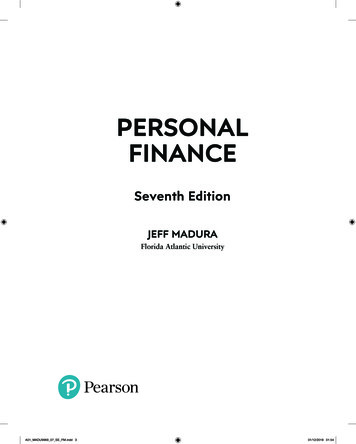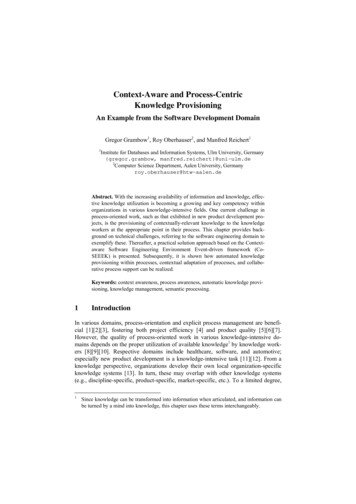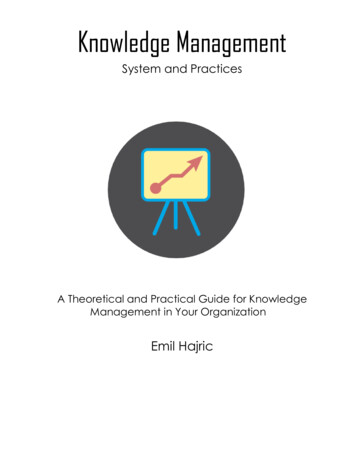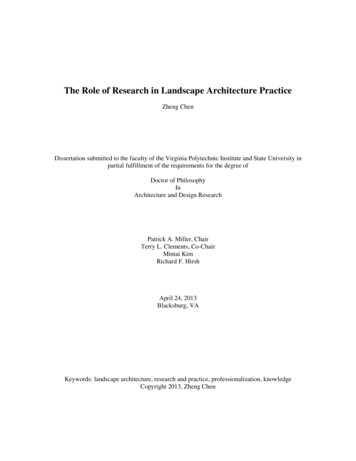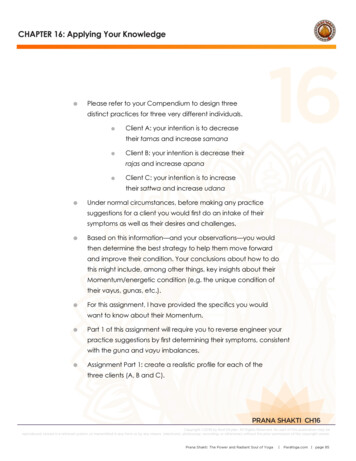
Transcription
CHAPTER 16: Applying Your Knowledgel16Please refer to your Compendium to design threedistinct practices for three very different individuals.lClient A: your intention is to decreasetheir tamas and increase samanalClient B: your intention is decrease theirrajas and increase apanalClient C: your intention is to increasetheir sattwa and increase udanalUnder normal circumstances, before making any practicesuggestions for a client you would first do an intake of theirsymptoms as well as their desires and challenges.lBased on this information––and your observations––you wouldthen determine the best strategy to help them move forwardand improve their condition. Your conclusions about how to dothis might include, among other things, key insights about theirMomentum/energetic condition (e.g. the unique condition oftheir vayus, gunas, etc.).lFor this assignment, I have provided the specifics you wouldwant to know about their Momentum.lPart 1 of this assignment will require you to reverse engineer yourpractice suggestions by first determining their symptoms, consistentwith the guna and vayu imbalances.lAssignment Part 1: create a realistic profile for each of thethree clients (A, B and C).PRANATANTRASHAKTISHAKTICH16M1Copyright 2016 by Rod Stryker, All Rights Reserved. No part of this publication may bereproduced, stored in a retrieval system, or transmitted in any form or by any means (electronic, photocopy, recording, or otherwise) without the prior premission of the copyright owner.Prana Shakti: The Power and Radiant Soul of Yoga ParaYoga.com page 85
linclude specifics about each one’s age,lifestyle, job, describe what got them tothe place where they need to have thepractice that you will suggestlinclude your insights about their particularlevel of desire to change as well as what16you perceive as their potential level of compliance(time they will actually set aside for practice and thefrequency that they will actually do it); this will affectwhat you suggest––the specific modalities as well asthe length of time and frequency of the practiceyou will recommendlthese insights are part of your description of themand their client profilelDon’t make this exercise more difficult than it needs to be:lrefrain from exaggerating their symptoms or issues;stay as practical as you can; make the person asreal as possiblelkeep in mind that the more intense their symptoms,the more intense the intervention will need to be tobe effective––thus, the more imbalanced they are,the bigger your tasklif they are new to personal practice or deeplyembedded in non-constructive tendencies it willmake it that much harder to affect them positivelylboth the profile of the person you are working withas well as your suggestions for them must be realisticPRANATANTRASHAKTISHAKTICH16M1Copyright 2016 by Rod Stryker, All Rights Reserved. No part of this publication may bereproduced, stored in a retrieval system, or transmitted in any form or by any means (electronic, photocopy, recording, or otherwise) without the prior premission of the copyright owner.Prana Shakti: The Power and Radiant Soul of Yoga ParaYoga.com page 86
lPart 2: determine the specific subtle essence you willfocus on in order to remedy their symptoms related totheir specific vayu and guna imbalance(s).lPart 3: based on Part 2, suggest two lifestyle changesto build the subtle essence.lPart 4: a) specify the particular category of asana your16client needs to emphasize and b) list the apex pose andthree to five poses that you would recommend they usethat lead up to the apex pose.lPart 5: determine the preferred pranayama you would recommend,however be mindful that it needs to be appropriate for them(i.e. age, capacity, previous experience, physical limitations)––yourclient may not yet be ready to do pranayama, therefore youmay want to consider if their pranayama should be limited to theirasana practice.lPart 6: Meditation. What is your recommendation? If it is appropriate,consider the use of a preliminary meditation as well as a culminatingmeditation practice.lSome additional hints:lresist the desire to give too much; it is possible, and maybe absolutely appropriate that you will simply focus ona single vayu or just direct them to practice yoga nidrainstead of meditationlbe responsive to the person as if they were an actual,living, breathing clientlbe responsive to their unique capacities, needs, theirlevel of compliance and desire to changePRANATANTRASHAKTISHAKTICH16M1Copyright 2016 by Rod Stryker, All Rights Reserved. No part of this publication may bereproduced, stored in a retrieval system, or transmitted in any form or by any means (electronic, photocopy, recording, or otherwise) without the prior premission of the copyright owner.Prana Shakti: The Power and Radiant Soul of Yoga ParaYoga.com page 87
lIMPORTANT: be attentive to and make yoursuggestions informed by the principles relating to:lone, the stages of life and therecommendations for how a practiceshould be partitioned (asana, pranayama,and meditation)l16two, the general principle related to working withclients and the gunas––that is to say the progressivenature of first reducing tamas (which is what wewould normally ascribe to most beginning students),then reducing rajas (commonly consistent with anintermediate stage); finally, while increasing sattwais appropriate at every stage of practice, it becomesthe primary focus of practice only after the first twoimbalances have been remediedlthus, you can assume that Client C is further alongin their yoga practice and their personal growth anddevelopment than Clients A and Blif you choose to give any of your clients a mantra,then select one from the five open mantras; indicatewhich one you would suggestlyou will complete the exercise under the assumptionthat this is your first meeting with them, but that the twoof you will meet again to refine their practice in6 monthslyour suggestions (in Steps 1 - 6) are intended to improvetheir condition in the very short termPRANATANTRASHAKTISHAKTICH16M1Copyright 2016 by Rod Stryker, All Rights Reserved. No part of this publication may bereproduced, stored in a retrieval system, or transmitted in any form or by any means (electronic, photocopy, recording, or otherwise) without the prior premission of the copyright owner.Prana Shakti: The Power and Radiant Soul of Yoga ParaYoga.com page 88
l16Determine whether the client is a beginner,intermediate or advanced student. This is notan arbitrary decision but should be based onand consistent with the given specifics relatedto each client (i.e. increase their sattwa andincrease their udana).lPart 7: You will now meet with your clients sixmonths later. They may have done everything yousuggested; they may have done little. Describe thespecifics of your new suggestions plan (if they havechanged or if they have not changed).Address all of the same steps (1 – 6) above.Prana and the Power to Heal Others - The Unconditional Healing PracticelAll physical healing is an expression of both the intelligenceand awakened force of dharma.lBy learning to become a conduit of prana you can affecthealing on any of many different levels.lSince healing can and does occur on many levels, someof which are not material, you may or may not be able toperceive the healing that you have channeled.lThe more you can step away from your personality in theprocess––transforming yourself into a pure, unconditionedchannel for prana shakti––the more concentrated andpotentially effective the healing you can provide.lthe key is to draw, not from your personalreservoir of prana; but from the boundlesspool of universal energyPRANATANTRASHAKTISHAKTICH16M1Copyright 2016 by Rod Stryker, All Rights Reserved. No part of this publication may bereproduced, stored in a retrieval system, or transmitted in any form or by any means (electronic, photocopy, recording, or otherwise) without the prior premission of the copyright owner.Prana Shakti: The Power and Radiant Soul of Yoga ParaYoga.com page 89
lwhen you have an emotional stake in16healing someone, there is a good chance you,at some level, are personally invested in theirtransformation resulting in something specificlpersonal investment creates attachment;attachment creates limits, which subvertyour power as a healing channellthe more you can surrender your own pointof view and finite understanding or concernabout this situation, the more you can be achannel for healinglconsider the practice purely as seva(service or offering)llsuch an offering is the living expression of yogaWhen you have achieved a sense of fullness and love younaturally become drawn to being more compassionate, youcan truly become a beacon of light and healing.lwhile doing the practice, be mindful of thedistinction between empathy (personal) andcompassion (universal, unconditional)lunconditionally offering healing to another is toheal yourself on some levellas with all kriya meditations, the key is to startimmersed in prana dharana and allow it to guideyou throughout the practicelWhile doing the practice be free. Enjoy. Be the gift ofunconditional love.PRANATANTRASHAKTISHAKTICH16M1Copyright 2016 by Rod Stryker, All Rights Reserved. No part of this publication may bereproduced, stored in a retrieval system, or transmitted in any form or by any means (electronic, photocopy, recording, or otherwise) without the prior premission of the copyright owner.Prana Shakti: The Power and Radiant Soul of Yoga ParaYoga.com page 90
CHAPTER 17: Closing Thoughts: On Sustainability and Supreme SuccesslYou can be a master of asana, have extraordinarycontrol of your body, sit in meditation for hours on end,and have tons of students and still be imbalanced,lack integration and be less than fully stable, awake17and free.lBe a complete person.lThe point is: your accomplishments in practice are insignificantcompared to what really matters––the quality of your life andhow you are impacting the world when you are not practicing.lBeing a complete and integrated person is the ultimateaccomplishment.lIt’s vital to embody higher and enduring values and that youare worthy of respect, both from yourself and others.lIf ParaYoga is going to be sustainable and continue to offerreal value to those it will touch long into the future it will need toconsistently follow these key principles: Self-Reliance, Integrity,Empowerment, Guardianship, Love of Life.1. Self-ReliancelTake responsibility for your experience of the world.lInstead of blaming others or conditions of the world, look tounderstand yourself. You are the source of your pain.lAlways remember to exercise the principle of svadhyaya,understand yourself from every angle, all the roles you play,gain insight as to how these roles relate to one another.PRANATANTRASHAKTISHAKTICH17M1Copyright 2016 by Rod Stryker, All Rights Reserved. No part of this publication may bereproduced, stored in a retrieval system, or transmitted in any form or by any means (electronic, photocopy, recording, or otherwise) without the prior premission of the copyright owner.Prana Shakti: The Power and Radiant Soul of Yoga ParaYoga.com page 91
l17Look to improve yourself and to become a livingexample of yourself and to others about what youwish to be and become.lBe intellectually and spiritually curious. Don’t be alightweight. Become an embodiment of theseteachings so you carry the weight and breadthof these teachings. Be substantial.2. IntegritylAct in such a way that you have nothing to hide, nothingto fear, nothing to regret. Act so you will not have to carry theburden of guilt or shame. Act so that your conscience is clear.lMake the impact of your actions a higher priority than theshort-term pleasure they would otherwise provide.lObserve your speech. Watch how much you are critical of others,put others down or gossip. The more evolved you are, the less yougossip, the less you are motivated to talk negatively about others,including other approaches to yoga.lLook people in the eye. Truly see others and truly let yourselfbe seen.lAlways consider how you can build a history of actions thatare sustainable and stable long into the future.lIt may be helpful to acknowledge that it is often easier to dobad than it is to do good. To do good over the long term requiresvigilance and self-awareness as well as commitment to purposeand a meaningful end.lIf your life will be meaningful in the end, then act withpurpose and be mindful along the way to that end.PRANATANTRASHAKTISHAKTICH17M1Copyright 2016 by Rod Stryker, All Rights Reserved. No part of this publication may bereproduced, stored in a retrieval system, or transmitted in any form or by any means (electronic, photocopy, recording, or otherwise) without the prior premission of the copyright owner.Prana Shakti: The Power and Radiant Soul of Yoga ParaYoga.com page 92
l17As a yoga teacher you will impact others, not justthe students in your class. Become a dependableand bright beacon in the life of your studentsand you will wind up not only affecting them butthe lives of those who your students touch as well.llStay mindful of the Four Gates of Speech:lIs it true?lIs it necessary?lIs it timely?lIs it kind?Is what you are inclined to say true? Next, ask yourself is itnecessary? Then, is it timely? Is it going to contribute positivelyto this moment? And, finally is it kind? Only if you can passthese four gates of speech would you say it. If not, justkeep it to yourself.lAll human beings are looking to see and to be seen. Offerboth when you interact with people. Make eye-to-eye contact.Make yourself available for the seer in them to see you.lBring depth and elevation to all of your relationships, whetherstudents, parents or whomever it is.3. EmpowermentlNever stop growing. Don’t be content with your current levelof accomplishment. Grow your knowledge, keep growing.lSo many teachers stop being students. The idea that you havemastered this knowledge is a convenient, but destructive illusion––you never master it.PRANATANTRASHAKTISHAKTICH17M1Copyright 2016 by Rod Stryker, All Rights Reserved. No part of this publication may bereproduced, stored in a retrieval system, or transmitted in any form or by any means (electronic, photocopy, recording, or otherwise) without the prior premission of the copyright owner.Prana Shakti: The Power and Radiant Soul of Yoga ParaYoga.com page 93
lThe greatest teachers are the greatest students.lAn ancient scripture tells us that, “A person must17never be satisfied with what he or she possesses.Fortune abandons the one who is content withwhat he has.”lStay ambitious as it relates to how you can benefit thisworld, even if you are benefiting only one person.lLive by the motto: I can do better, I can and will andmust be my best.lEmbody your potential.4. GuardianshiplI hold all of these principles dear, but what inspires andmotivates me the most is this principle––guardianship.lIndeed, ParaYoga is one of the few modern styles of yoga thatcan point to itself as being part of an unbroken lineagethat dates back centuries and in which the teachings are holistic.This is a stream of vedic knowledge, as seen by and taught byillumined beings and living sages.lThe point is you can have a role in propagating and continuingto grow this wisdom in the modern age, provided you are acomplete person.lYou can’t be a beacon of this wisdom if you are not workingon yourself.lWe are protecting, enlivening, and sharing with the studentsof today the best of what we have learned from this traditionand lineage.PRANATANTRASHAKTISHAKTICH17M1Copyright 2016 by Rod Stryker, All Rights Reserved. No part of this publication may bereproduced, stored in a retrieval system, or transmitted in any form or by any means (electronic, photocopy, recording, or otherwise) without the prior premission of the copyright owner.Prana Shakti: The Power and Radiant Soul of Yoga ParaYoga.com page 94
lBe respectful of what you have received.lcountless times you hear me refer to whatmy teachers have taught me,“I have learned this from my teachers”or “my teachers taught me thismethodology”l17there’s very little new in what I have taughtyou, a handful of things I have collated or distilledso that I could teach them to you, but little, ifanything is new––self-createdlin terms of the meditations or Ayurvedic principlesI have taught you, as well as the mantras, they allhave come from my teacherslI only provide mantras authentic to my lineage,I don’t make them uplthe good news: you don’t have to spend any timetrying to make things up because this system offersso muchlI feel I am a guardian because I so respect what I have learned.lBy becoming a full person and drawing on this time-testedknowledge, the teachings come alive in you. This powerfulquote was passed on to me by a student, its source is unknown:l“the role of the teacher is not to necessarilyinnovate but to transmit as precisely as possiblewhat she or he has received. The teacher cannotsimply hide behind a tradition. His or her task is tosee how deeply he or she has integrated theheritage he or she has been given and if they haveunderstood it well enough so that when theyPRANATANTRASHAKTISHAKTICH17M1Copyright 2016 by Rod Stryker, All Rights Reserved. No part of this publication may bereproduced, stored in a retrieval system, or transmitted in any form or by any means (electronic, photocopy, recording, or otherwise) without the prior premission of the copyright owner.Prana Shakti: The Power and Radiant Soul of Yoga ParaYoga.com page 95
explain it communicates their own experienceas well as the experience of the ancient wisdom,then they become inseparable from that ofthe teachers that have preceded them. Theteacher is the teachings and that is what makeshim or her so precious”lThis means study, respect your teachers and take what17you have learned and in your own and best authentic way,share it with those who come to you to feel better, beuplifted and enlightened.lA critical question to constantly ask yourself is, “are you teachingto impress people or are you teaching to provide something thatreally helps and uplifts them?”lCan you teach in a way that is simpler, more accessible andmore easily relatable to the people you are teaching? In otherwords, don’t share the likes of the Cave of the Heart practicebecause you can or you want to blow some people away––share it only when it’s precisely the right time to do so.lmight a simpler practice like heart kriya or seeingsky blue light or spaciousness in the heart bemore appropriatelwhat can you teach that is as accessible as possible,that gives students what they needlCompassion will provide you the clarity to know what peopleneed, as opposed to what you need to elevate yourself in theireyes as an esteemed and wonderful teacher.PRANATANTRASHAKTISHAKTICH17M1Copyright 2016 by Rod Stryker, All Rights Reserved. No part of this publication may bereproduced, stored in a retrieval system, or transmitted in any form or by any means (electronic, photocopy, recording, or otherwise) without the prior premission of the copyright owner.Prana Shakti: The Power and Radiant Soul of Yoga ParaYoga.com page 96
175. Love of LifelIn the end, ParaYoga is system that reminds andempowers you to celebrate life.lBecome awake, joyous in the fact that through thesemethodologies, you can experience the beauty ofdivine grace and sacredness. You can experience itwhen you are alone, in a crowd, walking, sitting, atthe movies everything is for your enjoyment.lThe whole world is to provide you with the opportunity tostrengthen and enliven your experience of bhoga, delightin the world, as well as the light of spirit. There is so muchto appreciate.lThe large compendium of modalities, the huge amountof knowledge contained in these four trainings, and theknowledge ParaYoga offers beyond these trainings, isultimately about having more joy and freedom.lEnjoy it all.lTrust that you can laugh and love and find evermorebeauty in life, despite all its ambiguity and challenges andinevitable change.lBy becoming a master of yourself, by acting with integrity,taking ownership of your life, by taking responsibility, you cantruly soak in this exceptional experience of life.lDo this and, I am quite convinced, you will not only behappier, you will help bring greater credibility to yoga, andyou will provide something of real meaning for generationsto come.lLife is precious. It is a gift. Enjoy it.PRANATANTRASHAKTISHAKTICH17M1Copyright 2016 by Rod Stryker, All Rights Reserved. No part of this publication may bereproduced, stored in a retrieval system, or transmitted in any form or by any means (electronic, photocopy, recording, or otherwise) without the prior premission of the copyright owner.Prana Shakti: The Power and Radiant Soul of Yoga ParaYoga.com page 97
in their yoga practice and their personal growth and development than Clients A and B l if you choose to give any of your clients a mantra, then select one from the five open mantras; indicate which one you would suggest l you will complete the exercise under the assumption th




